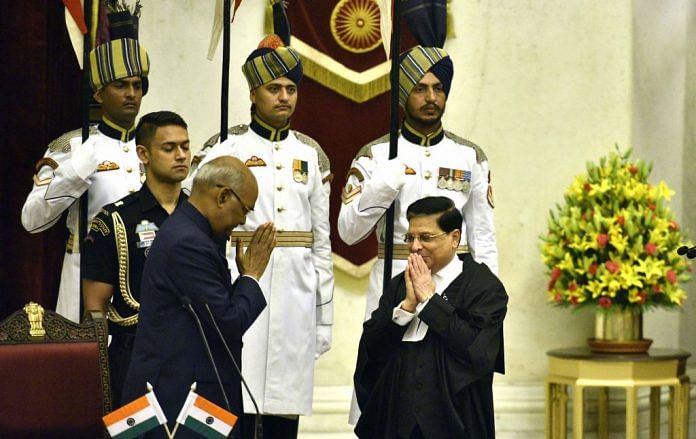Misra can still redeem the remainder of his term by calling a full house meeting of the court and addressing the grievances raised by senior judges and the bar.
To say that the tenure of Dipak Misra as the 45th Chief Justice of India has been eventful is a complete understatement.
So far, Misra’s 214 days as CJI have been replete with controversies. He still has 186 days to go. But the biggest controversy may just be the impeachment talk that surrounds him.
Being the CJI is the pinnacle of a judge’s professional life. Far from using this office to inspire confidence in the judiciary, Misra’s is a story of struggling to simply survive.
His troubles began much before he occupied the CJI’s office. First, his name featured in former Arunachal Pradesh CM Kalikho Pul’s purported suicide note along with other judges.
In 2016, an Odisha-based activist, Jayanta Kumar Das, had written to the then-CJI, saying Misra had misrepresented facts in trying to get hold of public land meant to be distributed to the landless poor. Complaints on the same issue culminated in a CBI probe and a case that eventually came to high court judge Indrajit Mohanty.
Months later, when Mohanty and another HC judge were being investigated separately for alleged misuse of authority, the name of a “senior Supreme Court judge” cropped up, indicating possible proximity to the judges. The inquiry committee mysteriously stopped midway and wrote to then CJI J.S. Khehar that they can no longer proceed with the investigation since they do not have the power to investigate an apex court judge.
All this was before Misra even became CJI. But even as eminent jurists like Shanti Bhushan questioned Misra’s probity, he went on to become the CJI.
Speculation swirled about a supersession that would bring Justice J. Chelameswar as CJI instead, but Misra’s name was recommended and accepted by the government. However, ahead of a new CJI taking office, such allegations and speculation about supersession are almost like a corridor tradition in the court.
Once he was in office, Misra must have been determined to put this behind him and create a legacy through his rulings. He started out by doing a U-turn from his predecessor’s stand on the controversial Hadiya case. While former CJI Khehar wanted a probe into whether Hadiya was brainwashed, Misra put his foot down that the court cannot question the agency of an adult.
Meanwhile, the Prasad Education Trust controversy was quietly brewing in the background. Allegations surfaced in October that the head of the medical college colluded with a middleman and a former judge of the Odisha HC, I.M. Quddusi, to “bribe judges of the Supreme Court”.
When Prashant Bhushan, Dushyant Dave and Kamini Jaiswal led the fight to have these allegations probed internally, Misra’s nemesis Chelameswar agreed. But Misra’s handling of the case was seen as a hurried attempt to scuttle any scrutiny.
While he and Chelameswar have not seen eye to eye since, many other judges also were forced to pick sides. As Misra looked for support among his colleagues, senior judges alleged that he allocated cases to a “preferred bench” of justice Arun Mishra.
The other judges frowned upon this too, for obvious reasons. Finally, as a show of strength, three other most senior judges joined Chelameswar in that historic press conference in January.
CJI Misra’s interactions with the executive on behalf of the judiciary have been closely monitored and duly recorded. Misra continued without officially responding, hoping the controversies would die a natural death.
For Misra, the biggest fear now will be to not go down as the first CJI who was sought to be impeached.
Since the medial college controversy, Misra has dedicated most of his judicial time to Constitution bench hearings. He is also hearing a couple of special bench cases like the Ayodhya dispute and the case related to judge B.H. Loya’s death.
He now equals former CJI K.G. Balakrishnan when it comes to heading Constitution benches — as many as 15, despite the fact that his tenure of 14 months will be considerably shorter than Balakrishnan’s three years and four months, one of the longest as CJI. The tenure of a CJI usually calculated by the number of working days, but given Misra’s troubles, each day is significant.
Every CJI’s tenure is examined in the light of whether he did a good or a bad job of handling his affairs, but for Misra, the commentary would be that he refused to make any effort to set his house in order. That it has led to talk of his impeachment shatters the faith placed in the office of a high constitutional functionary.
The opposition talk about impeachment is more damaging to the judiciary than the impeachment motion itself.
There’s still a way for Misra to redeem the remainder of his term that does not involve either impeachment or resignation — to call a full house meeting of the court and address the grievances raised by senior judges and the bar.
Even if he survives the present crisis by default, his perceived inaction on crucial issues will leave India’s already besieged judiciary with a lot to defend itself against.







जी, अगर इम्पीच्मेंट से बच गए तो।
अभी तक आप इतने सारे allegations को षड्यंत्र ही कहते रहेंगे ?
Impeachment would damage the institution. It becomes a political issue. However, many will wish that the time upto October passes swiftly.
क्या आदरणीय मिश्रा जी के रिटायरमेंट तक, उनके विरुद्ध षड्यंत्र चलते रहेंगे?
Mr Virendra Sason, I know that being a BHAKT is very responsible ‘job’ nowadays. But being a ANDH-BHAKT is really a challenging ‘job’!!